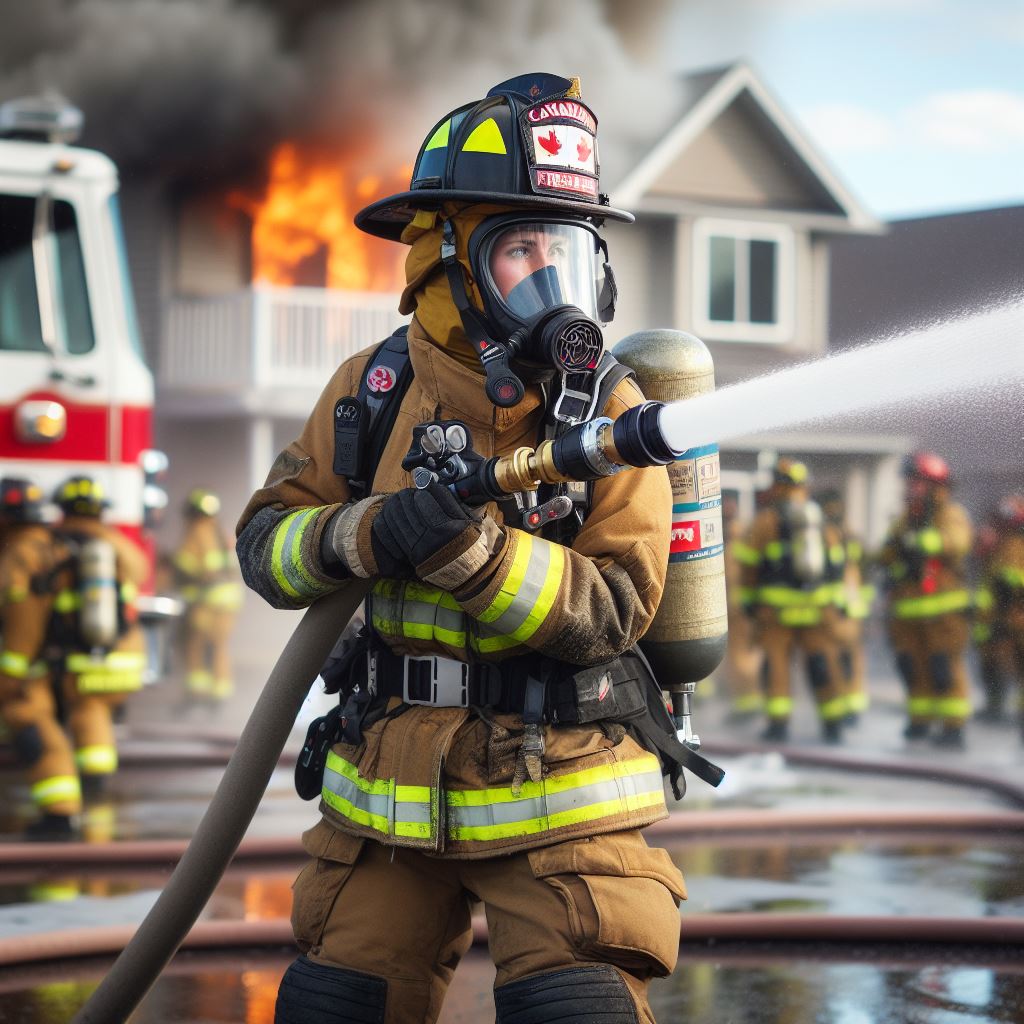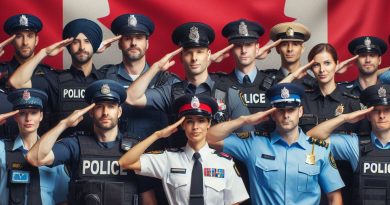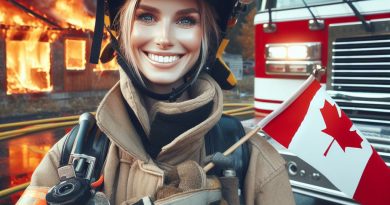Day in the Life of a Canadian Firefighter
Last Updated on January 28, 2024
Introduction
A Canadian firefighter plays a crucial role in maintaining public safety and protecting lives and property within the community.
Firefighters are highly important as they are trained professionals who are always ready to respond to emergencies.
Firefighters are responsible for extinguishing fires, rescuing people, and providing medical aid during emergencies. They undergo extensive training to develop the necessary skills and knowledge to deal with various types of emergencies.
In addition to fighting fires, Canadian firefighters also play an integral role in fire prevention.
They educate the community about fire safety, conduct inspections to ensure compliance with fire codes, and install smoke detectors in homes.
Firefighters are crucial for the well-being of the community. Not only do they possess the expertise to handle emergencies effectively, but they also provide reassurance to the public.
Knowing that there are skilled professionals available to respond to emergencies helps instill a sense of security within the community.
Furthermore, firefighters often participate in community outreach programs, such as school visits and community events, where they educate people about fire safety.
They also collaborate with other emergency services, such as police and paramedics, to ensure a coordinated response during critical situations.
In general, Canadian firefighters are vital members of the community who work tirelessly to protect lives and property.
Their role extends beyond fighting fires to include fire prevention, public education, and community outreach. Their dedication and bravery make them unsung heroes worthy of our respect and appreciation.
Education and Training
Overview of educational requirements
- Canadian firefighters must have at least a high school diploma or equivalent.
- Further education, such as a college diploma or university degree, can be beneficial.
- Firefighters undergo continuous training throughout their careers to keep up with new techniques and equipment.
The firefighter certification process
- Once the educational requirements are met, aspiring firefighters must complete a certification process.
- This process includes written and practical exams to assess proficiency in firefighting techniques.
- Training programs are offered by fire departments, colleges, and training academies across Canada.
Importance of physical fitness
- Physical fitness is crucial for firefighters due to the demanding nature of the job.
- Firefighters must pass rigorous physical tests as part of the certification process.
- Regular exercise and maintaining a healthy lifestyle are essential for firefighters to perform their duties effectively.
In order to become a Canadian firefighter, individuals must meet certain educational requirements.
While a high school diploma or equivalent is the minimum requirement, additional education, such as a college diploma or university degree, can be beneficial.
This additional education can provide firefighters with a deeper understanding of fire dynamics, emergency medical techniques, leadership skills, and more.
Continuous education and training throughout a firefighter’s career is also necessary to stay updated on new techniques and equipment.
Once the educational requirements are met, aspiring firefighters must go through a certification process.
This process typically includes both written and practical exams to assess their proficiency in various firefighting techniques.
These exams evaluate their knowledge of fire behavior, equipment usage, rescue procedures, and more.
To prepare for these exams, many individuals enroll in training programs offered by fire departments, colleges, and training academies across Canada.
These programs provide hands-on training and simulate real-life firefighting scenarios to enhance their skills.
Physical fitness plays a significant role in the lives of Canadian firefighters.
The nature of their job requires them to be physically fit and capable of enduring the demands of firefighting.
Physical tests are an integral part of the firefighter certification process and are used to assess applicants’ strength, endurance, and agility.
These tests often involve tasks such as ladder climbing, hose dragging, obstacle courses, and carrying heavy equipment.
Regular exercise and maintaining a healthy lifestyle are essential for firefighters to ensure they can perform their duties effectively and safely.
In short, the education and training process for Canadian firefighters is rigorous and comprehensive.
Meeting the educational requirements, undergoing certification exams, and maintaining physical fitness are all crucial elements of becoming and remaining a competent firefighter.
Continuous learning and staying updated on best practices are essential to effectively tackle the various challenges firefighters face daily.
Read: Ethical Dilemmas Faced by Policemen

Daily Routine
Start of shift and briefing
Every day begins with an energized firefighter ready to take on any challenges that may come their way. At the start of their shift, they gather for a briefing.
This briefing is an essential aspect of their routine as it allows them to discuss any updates, allocate tasks, and assign roles among the team members.
Regular equipment and vehicle checks
Before heading out for the day, Canadian firefighters diligently inspect their equipment and vehicles to ensure their readiness for any potential emergency.
From their protective gear to the fire engine, every detail is thoroughly examined, guaranteeing that all tools are in proper working condition.
Training exercises and drills
Continuous training is vital for firefighters to maintain their skills and stay up-to-date with the latest techniques and safety protocols.
During their daily routine, they participate in various training exercises and drills, simulating different emergency scenarios to enhance their preparedness.
Responding to emergency calls
When an emergency call comes in, Canadian firefighters promptly spring into action with their training and experience guiding their response.
They quickly gather their gear, jump into their vehicles, and rush to the scene to provide the necessary assistance and protection to the community.
Role during emergencies
During emergency situations, firefighters take charge of various tasks and responsibilities to ensure the safety of both lives and property.
They skillfully execute strategies, extinguish fires, perform rescue operations, provide medical aid, and support the affected individuals or families.
Collaborating with other emergency services
Collaboration and teamwork is key in emergency situations. Canadian firefighters work closely with other emergency services like police and paramedics.
They coordinate efforts, share information, and join forces to efficiently handle complex situations and minimize the potential risks and damages.
In fact, the daily routine of a Canadian firefighter is a challenging yet rewarding journey, driven by dedication and a relentless spirit to serve and protect their community.
From start to finish, their active involvement in various activities and collaboration with other emergency services make them the unsung heroes of our society.
Read: Balancing Work-Life in Police Careers
Typical Tasks and Responsibilities
Conducting fire inspections
As a Canadian firefighter, one of the essential tasks is conducting regular fire inspections to ensure public safety.
During these inspections, we check for fire hazards, verify the functionality of fire safety equipment, and educate property owners on fire prevention measures.
Conducting fire prevention and education programs
Another crucial responsibility we have is to conduct fire prevention and education programs in our communities.
We organize workshops, presentations, and demonstrations to raise awareness about fire safety, teaching people how to prevent fires and respond in case of emergencies.
Assisting with medical emergencies
Firefighters play a dual role as first responders, not only dealing with fire-related incidents but also providing assistance during medical emergencies.
We are trained in basic life-saving techniques, administering CPR, and providing initial medical aid until paramedics arrive.
Conducting rescue operations
When emergencies occur, we are called upon to conduct various types of rescue operations.
These can range from rescuing people trapped in burning buildings or crashed vehicles to assisting in water rescues or responding to natural disasters such as floods or earthquakes.
Maintaining equipment and apparatus
To perform our duties effectively, it is crucial to maintain our firefighting equipment and apparatus in excellent working condition.
We regularly inspect and service our helmets, breathing apparatus, hoses, pumps, and other tools to ensure their reliability during emergencies.
Being a firefighter in Canada is a challenging yet rewarding profession that involves various tasks and responsibilities.
With each task we undertake, we actively contribute to safeguarding lives and protecting our communities from the devastating effects of fires and other emergencies.
During fire inspections, we meticulously assess buildings, looking for potential fire hazards and ensuring compliance with safety regulations.
Fire prevention and education programs enable us to reach out to the public, educating them on the importance of fire safety and providing practical tips for preventing fires.
When medical emergencies occur, we are often the first on the scene, administering life-saving techniques and providing immediate assistance until medical professionals take over.
Rescue operations require us to remain calm under pressure, using our specialized training and equipment to extricate individuals from dangerous situations.
Regular maintenance of our equipment and apparatus is essential to ensure they function correctly when we need them the most.
By actively engaging in these tasks and responsibilities, we can effectively fulfill our duty to protect lives, property, and the environment from the devastation caused by fires and other emergencies.
Read: Canadian Police and International Cooperation
Challenges and Rewards
Handling high-stress situations
- Firefighters often face intense and dangerous situations that require them to remain calm and think quickly.
- Their ability to handle these high-stress situations can mean the difference between life and death.
- Training and experience help them develop the necessary skills to effectively manage emergencies.
- Despite the challenges, the adrenaline rush and sense of accomplishment when successfully resolving a crisis make it rewarding.
Physical and mental demands
- Being a firefighter requires excellent physical fitness and stamina to perform tasks in demanding environments.
- They must undergo rigorous training to build strength and endurance, preparing them for the physically demanding aspects of the job.
- Mentally, firefighters must remain focused and make split-second decisions in life-threatening situations.
- The combination of physical and mental demands can be both challenging and rewarding for firefighters.
Importance of teamwork and camaraderie
- Firefighters work closely together as a team, relying on each other for support and safety.
- Building strong bonds of trust and camaraderie is crucial for effective collaboration during emergencies.
- They train together and depend on each other to brave dangerous situations, fostering a strong sense of unity.
- The camaraderie among firefighters not only eases the pressure but also leads to lifelong friendships.
Saving lives and making a positive impact on the community
- One of the most fulfilling aspects of being a firefighter is the opportunity to save lives and make a tangible difference.
- They rescue people from burning buildings, provide medical aid, and protect communities during emergencies.
- Being part of a profession dedicated to helping others and improving the community brings immense satisfaction.
- The gratitude and appreciation received from those they assist further validate their important work.
Career growth opportunities and job security
- Firefighters have excellent opportunities for career growth, with various specialized roles and ranks to pursue.
- Through training and experience, they can become officers, instructors, or join specialized units like hazardous materials or technical rescues.
- Job security is also a notable benefit, as the demand for firefighters remains constant and essential in society.
- These factors give firefighters a sense of stability and the potential for a fulfilling long-term career.
Read: Youth Outreach Programs by Canadian Police
You Might Also Like: Cultural Sensitivity Training in Policing
Conclusion
Recap of the daily life of a Canadian firefighter
Throughout the day, Canadian firefighters tackle various emergencies and engage in rigorous training sessions.
Acknowledgment of the dedication and sacrifice firefighters make
Their commitment to serving and protecting their communities exemplifies their courage and selflessness.
Encouragement to appreciate and support their local firefighters
Let us recognize and honor the relentless efforts of these brave individuals who put their lives on the line.
Show gratitude and support by volunteering, donating, or simply spreading awareness about their vital role in society.
In essence, being a Canadian firefighter demands unwavering dedication, physical and mental strength, and a compassionate heart.
Their day-to-day life revolves around responding to emergencies and undertaking rigorous training to ensure they are always prepared.
Their sacrifices, both big and small, are often overlooked.
Let us take a moment to appreciate the commitment and bravery of our local firefighters and provide them with the support they need.
Together, we can create a safer and more grateful community.


